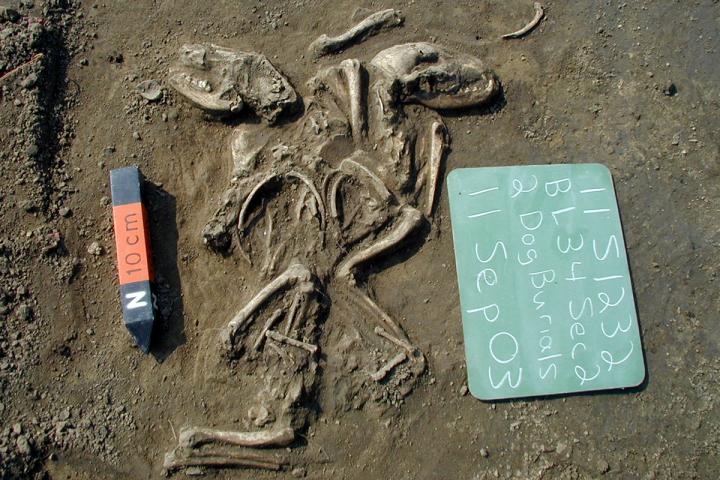Ancient Dogs of the Americas Were Wiped Out by European Colonization

Ancient dogs arrived in the Americas alongside humans more than 10,000 years ago but were later wiped out by European colonization, a new study suggests.
In fact, besides a few genes in some modern dogs today, the only trace of the original American dogs in today's canines is found in the form of a common canine tumor, according to the study, published today (July 5) in the journal Science.
The evolutionary history of dogs has always been a bit murky, as today's dogs are like a "soupy mix" of genes from various breeds, said co-lead study author Angela Perri, a research fellow at Durham University in England. But by looking at genes from more than 71 archaeological dog remains in North America and Siberia and comparing them with modern dog genes, the team was able to trace their elusive steps. [10 Things You Didn't Know About Dogs]
The new study dispelled a previous theory about the origin of dogs in the Americas, which posited that they evolved from domesticated wolves. The findings "put a nail in the coffin really for [that] idea," Perri told Live Science. In the new data, "we just had absolutely no evidence of that."
In the study, the researchers took DNA samples from dog remains that spanned time (throughout thousands of years) and space (North America and Siberia). Their findings suggested a Eurasian origin and, more specifically, a Siberian one: namely, that the first dogs came to the Americas more than 10,000 years ago, across the Bering land bridge, or Beringia, that connected North America and Asia. Afterward, the dogs dispersed across the Americas, where they lived for 9,000 years, isolated from the world.
But those dogs aren't the dogs you'll pet today. Rather, contemporary breeds likely stem from three more instances of dogs being brought to the Americas in the past 1,000 years, according to the study. Those include arctic dogs brought by the Thule people about 1,000 years ago that are the ancestors of dogs such as malamutes, huskies and Greenland sled dogs; dogs brought by Europeans starting in the 15th century; and Siberian huskies brought to the American Arctic during the Alaskan gold rush.
Colonization's devastating impact on dogs
By far, the introduction of European dogs had the biggest impact. "We suspect that a lot of the reasons [ancient] dogs were wiped out were similar reasons that Native American populations were destroyed," Perri said. Europeans could have brought over diseases such as rabies and canine distemper (similar to measles, but in dogs) that were probably not present in the Americas before, Perri said. But it's probably a combination of things, she added.
Sign up for the Live Science daily newsletter now
Get the world’s most fascinating discoveries delivered straight to your inbox.
"European colonists viewed native dogs as kind of pests, and they freely killed them," Perri said. Colonists who killed entire villages of people would also kill their dogs. And when some early Spanish explorers would find themselves without enough food, they'd tend to turn to native American dogs, she said. Finally, Europeans were probably being careful not to interbreed what they thought of as "prized" European dogs with "mongrel native" ones, she said. [The 10 Most Popular Dog Breeds]
Indeed, out of 5,000 samples of modern dog genes, only five had genes that belonged to ancient dogs, and in those five, the ancient genes made up less than 2 percent of their genomes, Perri said.
But ancient dog genes do live on in a surprising place: tumors.
Canine transmissible venereal tumors (CTVT) is a type of contagious canine genital cancer that can spread through mating. "This cancer has its own genome," Perri said. "The genome that it has is the genome of the very, very first" dog to get the disease.
Benjamin Sacks, a mammalian genetics professor at the University of California, Davis, who was not part of the research, said that while the ideas proposed in the study aren't new, "this study used the most extensive ancient and modern dog DNA sample to date … to conclusively confirm" these hypotheses.
Furthermore, "this study for the first time shows that the common ancestry to the original American dogs coincided with the peopling of the Americas," Sacks told Live Science in an email. Though more research is needed to confirm the hypothesis, "such a scenario is entirely plausible," he said. Some of the other proposed scenarios, such as the arrival of Thule dogs, might also need some more data to confirm, he added.
The oldest ancient American dog was found in Koster, Illinois, and lived around 9,900 years ago. This dog wasn't a giant, wolf-like creature as most would expect all ancient dogs to be, Perri said. Rather, it appeared to be sort of like a dingo. But Perri expects that there are many older ancient dogs yet to be found, since the first concrete evidence of human arrival to the Americas was dated to 4,500 years before that.
Originally published on Live Science.

Yasemin is a staff writer at Live Science, covering health, neuroscience and biology. Her work has appeared in Scientific American, Science and the San Jose Mercury News. She has a bachelor's degree in biomedical engineering from the University of Connecticut and a graduate certificate in science communication from the University of California, Santa Cruz.









